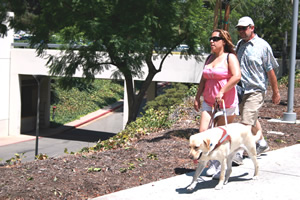Guiding the Blind
Dogs Help Their Handlers Get Around Campus and Raise Awareness
November 18, 2008
By Mimi Ko Cruz
Before Cal State Fullerton graduate student Anna Garzya got her guide dog, she used a cane to get around, but often fell and got lost. When she asked for directions from passersby, she frequently heard things like, “the bus is right over there.”
Not a useful response for a blind woman.
Thanks to her guide dog, Argent, Garzya said she feels safer and more independent.

Anna Garzya and her guide dog, Argent, walk to class together with help from Keith Tomlinson of Guide Dogs for the Blind of San Rafael. Photo by Mimi Ko Cruz
"My guide dog not only gives me independence, but I have an unconditional friend with me 24‑7," Garzya said, adding that when she lost her vision 20 years ago due to a condition called retinitis pigmentosa, her friends also deserted her and she became depressed. "I do not feel alone any longer. Before I got my first guide and during the time I was without a guide dog, I felt totally lost. With Argent, I can do most of the things I need to do."
Though she is more confident getting around, Argent sometimes gets distracted when people try to pet him and get his attention while he is working. Because today, Nov. 18, has been declared Guide Dog Day in California by Gov. Arnold Schwarzenegger, Cal State Fullerton’s blind students and staff members who have guide dogs are sharing their experiences and hoping to raise awareness among their sighted colleagues.
The day presents an educational opportunity, said Jeffrey C. Senge, coordinator of the campus Information and Computer Access Program in the Office of Disabled Student Services. He said there are about a dozen blind students, a couple of blind staff members and a blind professor on campus. About half use guide dogs on campus.
Senge, who also is blind, said all the dogs used by Cal State Fullerton’s students and staff came from Guide Dogs for the Blind in San Rafael. He said the organization is one of a few in the nation that has a field representative, Keith Tomlinson, who helps handlers with their dogs and provides support. Tomlinson has visited Cal State Fullerton to help acquaint the dogs and their handlers with the campus.
Senge, who serves on the Guide Dogs for the Blind Alumni Board of Directors and helps raise guide dog puppies,and his dog, Hobbit, have been companions for more than six years.
“Hobbit and I work as a team to safely get where we need to go,” he said. “Her job is to safely guide me around obstacles and alert me to elevation changes like stairs and curbs, as well as narrow areas and overhead objects like truck mirrors and tree branches. My job is to give her praise and corrections to keep her focused on doing her job. Squirrels, cats and other dogs, as well as people calling her name while she is working, can cause momentary distractions for a working dog and can put our safety at risk.”
Unlike a cane, a guide dog “has a brain and can make judgments,” Senge said. “That ability becomes important when trying to do something like cross the Cal State Fullerton Quad between classes.”
In an effort to help raise awareness about guide dogs and the job they do, Senge offers the following tips for sighted people:
• The best thing people can do is ignore the dog and focus on the person. Don’t say, “hi” to the dog, say “hi” to the person.
• When on campus, the dog is usually working or doing its best to behave. Both of these things are significant challenges for social animals like dogs. Guide dogs have to work hard at staying focused on their job in order to keep their partner safe. Calling their names, whistling or intentionally doing things to get their attention, even for a second, can cause them to lose focus, thus creating a potentially dangerous situation for the team.
• When the dogs aren’t working, they are expected to lay quietly and not bother others. This behavior is necessary for them to be welcome in public places. Most handlers have had to work long and hard to get their guide dogs to this level of excellent behavior and maintaining it is critical to the team’s success.
• If you want to know more about the dog, ask the handler. The person usually will be glad to answer questions and if you want to pet the dog, the handler will be able to determine if it’s OK.
• Never feed a guide dog. Guide dogs are on carefully managed diets. They have established feeding and relieving schedules. The introduction of inappropriate or unscheduled food can produce unpredictable events. Such events are most undesirable when they occur at inappropriate times or places.
As for people who are blind or visually impaired, Senge said, “it’s part of our identity. It’s who we are.
“To us, it’s not sad or tragic,” he added. “We really aren’t that much different from people who see well. We all have different talents and aspirations, some of us work hard and some take it easy, some of us are overachievers and some are underachievers. We like to laugh and have fun and develop friendships just like most folks.”
In the governor’s proclamation of Guide Dog Day, he notes:
“Guide dogs play a critical role in the lives of Californians who are legally blind …. It is important that we remember that guide dogs are working animals. We should always ask handlers if we can pet their companion beforehand and be aware of laws that allow service animals in public places. Many people are able to enjoy life more fully because of the assistance that a guide dog provides.”


